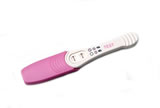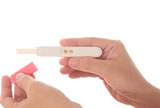Best Time to Get Pregnant
| on 09th March 2013 |
So you have decided that you are ready to begin trying to conceive and you can't wait to get started. This is a very exciting time, but do you know the time of the month that you are most likely to conceive? Tracking your fertility can make getting pregnant a little easier, and maybe even a little faster.

Your menstrual cycle begins by counting the first day your last period started until the first day of your next period. The menstrual cycle typically lasts between 28 and 32 days, but some women have cycles that are much longer or shorter than the average. Tracking your menstrual period can make it easier to know when you are ovulating and likely to become pregnant.
Ovulation occurs when an egg is released, and if fertilized will grow to be your long awaited baby. When the egg is not fertilized it dissolves and is released as your menstrual flow. Knowing when you are ovulating tells you the time period you should be focused on for intercourse if you are trying to get pregnant. If you use the first day of your last menstrual period as a starting point, most women ovulate between days eleven and twenty-one of their monthly cycle.
There are several different ways that you can track ovulation throughout your monthly cycle. You can use the calendar method, track your basal body temperature, read your cervical mucus or your saliva, or use an ovulation predictor test. All of these methods have been proven effective and many women who want to conceive use them regularly.
The calendar method also known as the rhythm method just involves the use of a calendar. Mark the first day of your period and then count forward ten to fourteen days. Make sure that you are having intercourse on day ten, day twelve, day fourteen, day sixteen, and day eighteen. Having sex every other day during days ten to twenty of your cycle ensures that you have live sperm ready to meet your egg when it is released. Sperm can live inside of a woman's reproductive tract for up to three days. This method does work, but it is not as precise as some of the other methods.
Tracking your basal body temperature is another way to monitor your body for ovulation. This method is a little more complicated than the calendar method. You will need a digital basal body temperature thermometer and a chart. Most of the thermometers come with a chart to get you started. To check your basal body temperature you simply need to use the thermometer first thing every morning before you get out of bed. You must check your temperature before you get up and start moving around. After you get your temperature just mark it down on your chart. When you ovulate your basal body temperature will rise. You can also use your basal body temperature to see whether or not you have conceived. If your basal body temperature stays higher when it should have dropped you are likely pregnant. For the first two weeks of your cycle your temperature will stay low, and then your temperature will go a little lower followed by a quick rise. The days where your temperature dips and then rises are when you are ovulating and may conceive. Your temperature will stay high for about two weeks and if you are not pregnant it will dip back down again. The downside to using the basal body temperature method is that you will have to track your temperature for a couple of months to accurately be able to tell when you are ovulating. Each month you will need to start a new chart.
Some women choose to chart their ovulation by monitoring their saliva. To monitor your saliva you will need a saliva monitoring test kit. These kits are fairly inexpensive and very easy to use. When you are ovulating your estrogen level goes up. This increase in estrogen will cause your saliva to form a "ferning" pattern when it dries. To use one of the kits you simply place a small amount of saliva on the lens, wait for it to dry, and then take a look. Most test kits have a light and microscope attached to make it easier to see the pattern. When your saliva ferns or forms a frost like pattern you are ovulating and may conceive.
You can also monitor your cervical mucus to predict ovulation. Some women are uncomfortable using this method, but once you get the hang of it it's really easy to do. Monitoring your cervical mucus involves sliding one clean finger up into your vagina to get a sample from near your cervix. You will then need to both look at and feel what you find. If there is not much of a sample there then you are not close to ovulation, if what you find is kind of creamy then you are nearing ovulation, if what you find is watery and thin ovulation is near and you can go ahead with intercourse. If you take a sample of your cervical mucus and resembles a raw egg white then you are ovulating and should definitely be having intercourse. Most women have to track their cervical mucus for a couple of months to be really sure of when they are ovulating.
You may choose to use an ovulation predictor kit. These kits are very easy to use and just involve putting a test strip in a stream or container of urine. When the strip turns the same color or darker than the control band you are ovulating. The test strips work by measuring the luteinizing hormone levels in your urine. Shortly before ovulation occurs the luteinizing hormone levels are higher and this is when you should try for conception.
All of these methods are effective and can help you on your path to conception. You may want to use more than one method of predicting ovulation to give you the most accurate results. A benefit of all of these methods is that they put you more in tune with your body, and that may give you the cues you need to realize you have conceived almost immediately.
Video Source: Youtube
Copyright © 2012 Babiesbase.and respective owners. All rights reserved.
Other product and company names shown may be trademarks of their respective owners.











 Sign up for our week by week
Sign up for our week by week

